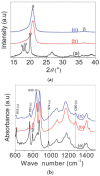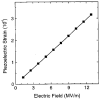A Comprehensive Review of Piezoelectric PVDF Polymer Fabrications and Characteristics
- PMID: 40283263
- PMCID: PMC12029650
- DOI: 10.3390/mi16040386
A Comprehensive Review of Piezoelectric PVDF Polymer Fabrications and Characteristics
Abstract
Polyvinylidene fluoride (PVDF) polymer films, renowned for their exceptional piezoelectric, pyroelectric, and ferroelectric properties, offer a versatile platform for the development of cutting-edge micro-scale functional devices, enabling innovative applications ranging from energy harvesting and sensing to medical diagnostics and actuation. This paper presents an in-depth review of the material properties, fabrication methodologies, and characterization of PVDF films. Initially, a comprehensive description of the physical, mechanical, chemical, thermal, electrical, and electromechanical properties is provided. The unique combination of piezoelectric, pyroelectric, and ferroelectric properties, coupled with its excellent chemical resistance and mechanical strength, makes PVDF a highly valuable material for a wide range of applications. Subsequently, the fabrication techniques, phase transitions and their achievement methods, and copolymerization and composites employed to improve and optimize the PVDF properties were elaborated. Enhancing the phase transition in PVDF films, especially promoting the high-performance β-phase, can be achieved through various processing techniques, leading to significantly enhanced piezoelectric and pyroelectric properties, which are essential for diverse applications. This concludes the discussion of PVDF material characterization and its associated techniques for thermal, crystal structure, mechanical, electrical, ferroelectric, piezoelectric, electromechanical, and pyroelectric properties, which provide crucial insights into the material properties of PVDF films, directly impacting their performance in applications. By understanding these aspects, researchers and engineers can gain valuable insights into optimizing PVDF-based devices for various applications, including energy-harvesting, sensing, and biomedical devices, thereby driving advancements in these fields.
Keywords: characterizations; fabrication; material properties; piezoelectric; poly(vinylidene fluoride).
Conflict of interest statement
Author Shihai Zhang was employed by the company PolyK Technologies, LLC. The remaining authors declare that the research was conducted in the absence of any commercial or financial relationships that could be construed as a potential conflict of interest.
Figures




































Similar articles
-
Composites, Fabrication and Application of Polyvinylidene Fluoride for Flexible Electromechanical Devices: A Review.Micromachines (Basel). 2020 Dec 3;11(12):1076. doi: 10.3390/mi11121076. Micromachines (Basel). 2020. PMID: 33287450 Free PMC article. Review.
-
Future prospects and recent developments of polyvinylidene fluoride (PVDF) piezoelectric polymer; fabrication methods, structure, and electro-mechanical properties.RSC Adv. 2023 Jan 9;13(1):370-387. doi: 10.1039/d2ra06774a. eCollection 2022 Dec 19. RSC Adv. 2023. PMID: 36683768 Free PMC article. Review.
-
Effects of Porosity on Piezoelectric Characteristics of Polyvinylidene Fluoride Films for Biomedical Applications.BME Front. 2023 Jul 7;4:0009. doi: 10.34133/bmef.0009. eCollection 2023. BME Front. 2023. PMID: 37849669 Free PMC article.
-
Thermally Stable Poly(vinylidene fluoride) for High-Performance Printable Piezoelectric Devices.ACS Appl Mater Interfaces. 2020 May 13;12(19):21871-21882. doi: 10.1021/acsami.0c03675. Epub 2020 Apr 30. ACS Appl Mater Interfaces. 2020. PMID: 32316731
-
Multifunctional Lead-Free Halide Perovskite Based Poly(vinylidene fluoride) Composites for Biomechanical Energy Harvesting and Self-Powered Piezo-Optoelectronic Applications.ACS Appl Mater Interfaces. 2025 Mar 26;17(12):18813-18830. doi: 10.1021/acsami.4c21089. Epub 2025 Mar 14. ACS Appl Mater Interfaces. 2025. PMID: 40085747
Cited by
-
Treatment of Natural Rubber Skim Latex Using Ultrafiltration Process with PVDF-TiO2 Mixed-Matrix Membranes.Polymers (Basel). 2025 Jun 8;17(12):1598. doi: 10.3390/polym17121598. Polymers (Basel). 2025. PMID: 40574126 Free PMC article.
-
Piezoelectric-Driven Amplification of Plasmon-Enhanced Fluorescence for Advanced Sensing Applications.ACS Appl Mater Interfaces. 2025 May 14;17(19):28881-28893. doi: 10.1021/acsami.5c03428. Epub 2025 May 5. ACS Appl Mater Interfaces. 2025. PMID: 40324944 Free PMC article.
-
Advancing Nanogenerators: The Role of 3D-Printed Nanocomposites in Energy Harvesting.Polymers (Basel). 2025 May 16;17(10):1367. doi: 10.3390/polym17101367. Polymers (Basel). 2025. PMID: 40430661 Free PMC article. Review.
References
-
- Smith M., Kar-Narayan S. Piezoelectric polymers: Theory, challenges and opportunities. Int. Mater. Rev. 2022;67:65–88. doi: 10.1080/09506608.2021.1915935. - DOI
-
- Ramadan K.S., Sameoto D., Evoy S. A review of piezoelectric polymers as functional materials for electromechanical transducers. Smart Mater. Struct. 2014;23:033001. doi: 10.1088/0964-1726/23/3/033001. - DOI
-
- Gao X., Yang J., Wu J., Xin X., Li Z., Yuan X., Shen X., Dong S. Piezoelectric Actuators and Motors: Materials, Designs, and Applications. Adv. Mater. Technol. 2020;5:1900716. doi: 10.1002/admt.201900716. - DOI
-
- Mishra S., Unnikrishnan L., Nayak S.K., Mohanty S. Advances in Piezoelectric Polymer Composites for Energy Harvesting Applications: A Systematic Review. Macromol. Mater. Eng. 2019;304:1800463. doi: 10.1002/mame.201800463. - DOI
-
- Ueberschlag P. PVDF piezoelectric polymer. Sens. Rev. 2001;21:118–126. doi: 10.1108/02602280110388315. - DOI
Publication types
LinkOut - more resources
Full Text Sources

